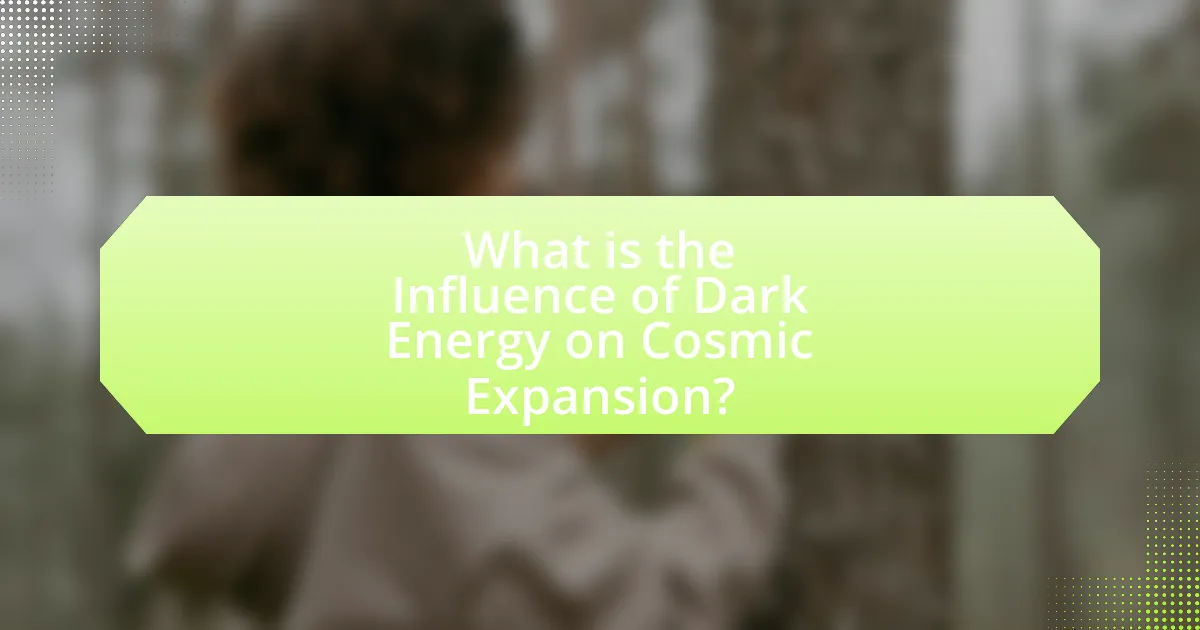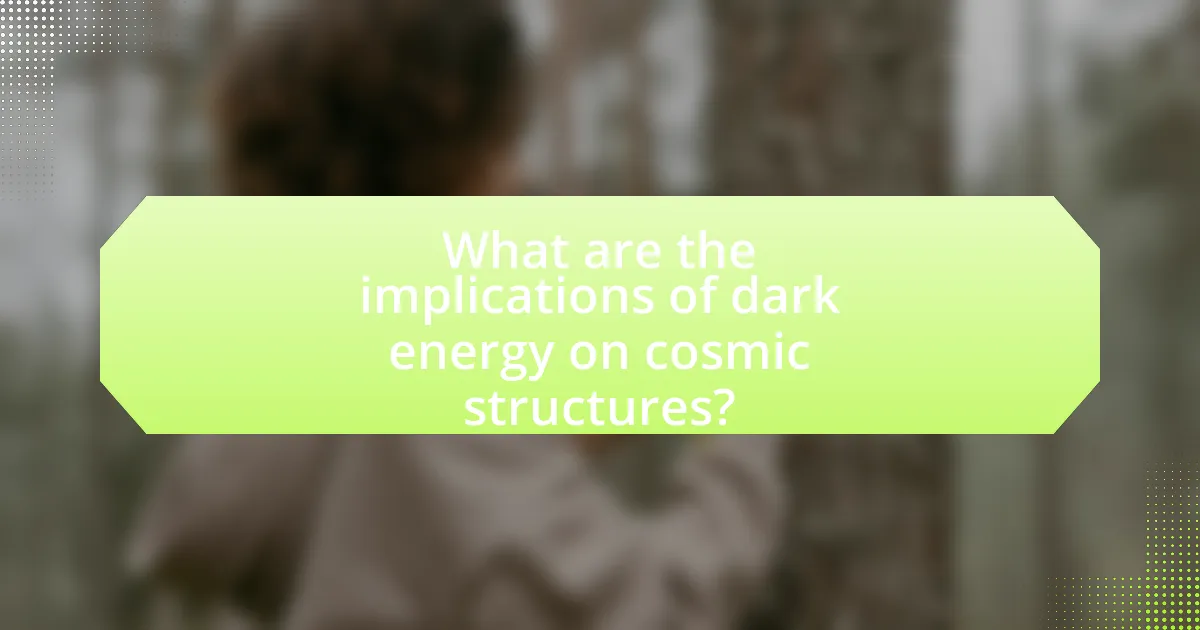Dark energy is a mysterious form of energy that constitutes approximately 68% of the universe and plays a crucial role in driving its accelerated expansion. This article explores the influence of dark energy on cosmic expansion, detailing how it exerts a negative pressure that counteracts gravitational forces, leading to an increasing rate of expansion observed through studies of distant supernovae and cosmic microwave background radiation. It discusses the evidence supporting dark energy’s existence, various theories explaining its nature, and the implications for the universe’s fate and structure. Additionally, the article highlights the need for future research and technological advancements to deepen our understanding of dark energy and its impact on cosmology.

What is the Influence of Dark Energy on Cosmic Expansion?
Dark energy significantly influences cosmic expansion by driving the accelerated expansion of the universe. This mysterious form of energy, which constitutes approximately 68% of the universe, exerts a negative pressure that counteracts the gravitational forces of matter. Observations, such as those from Type Ia supernovae, indicate that the rate of expansion of the universe is increasing, a phenomenon attributed to dark energy. The discovery of this acceleration was pivotal, leading to the conclusion that dark energy plays a crucial role in shaping the large-scale structure and future evolution of the cosmos.
How does dark energy contribute to the acceleration of the universe’s expansion?
Dark energy contributes to the acceleration of the universe’s expansion by exerting a negative pressure that counteracts the attractive force of gravity. This phenomenon was first observed through the study of distant supernovae, which revealed that the universe is not only expanding but doing so at an increasing rate. The discovery, published in 1998 by the Supernova Cosmology Project and the High-Z Supernova Search Team, provided strong evidence for the existence of dark energy, estimated to make up about 68% of the total energy density of the universe. This negative pressure leads to a repulsive effect on cosmic scales, causing galaxies to move away from each other more rapidly over time.
What evidence supports the existence of dark energy?
The evidence supporting the existence of dark energy includes observations of the accelerated expansion of the universe, particularly through the study of distant supernovae. The discovery of Type Ia supernovae in the late 1990s revealed that these stellar explosions were fainter than expected, indicating that the universe’s expansion is accelerating rather than slowing down due to gravitational attraction. This acceleration implies the presence of a repulsive force, attributed to dark energy, which constitutes approximately 68% of the universe’s total energy density. Additionally, measurements of the cosmic microwave background radiation, particularly from the Wilkinson Microwave Anisotropy Probe (WMAP) and the Planck satellite, provide further evidence by showing that the geometry of the universe is flat, consistent with a model that includes dark energy. These findings collectively reinforce the conclusion that dark energy is a fundamental component driving the current dynamics of cosmic expansion.
How is dark energy measured in cosmological studies?
Dark energy is measured in cosmological studies primarily through observations of distant supernovae, cosmic microwave background radiation, and large-scale structure of the universe. These methods allow scientists to infer the rate of cosmic expansion and the influence of dark energy on it. For instance, the discovery of the accelerated expansion of the universe was made possible by analyzing Type Ia supernovae, which serve as standard candles for measuring astronomical distances. Additionally, the Cosmic Microwave Background data from missions like the Wilkinson Microwave Anisotropy Probe (WMAP) provides insights into the universe’s composition, including dark energy, by examining temperature fluctuations. The large-scale structure of the universe, mapped through galaxy surveys, also reveals how dark energy affects the growth of cosmic structures over time.
Why is understanding dark energy crucial for cosmology?
Understanding dark energy is crucial for cosmology because it constitutes approximately 68% of the universe and drives its accelerated expansion. This phenomenon was first observed in 1998 through supernova studies, which revealed that the universe is not only expanding but doing so at an increasing rate. Dark energy’s properties influence the ultimate fate of the universe, determining whether it will continue to expand indefinitely, eventually halt, or collapse. The precise nature of dark energy remains one of the most significant unsolved problems in physics, as it challenges existing theories of gravity and the fundamental understanding of the universe’s composition.
What role does dark energy play in the fate of the universe?
Dark energy is the dominant force driving the accelerated expansion of the universe, significantly influencing its ultimate fate. This mysterious form of energy constitutes approximately 68% of the universe and exerts a negative pressure that counteracts gravitational attraction. Observations, such as those from the Supernova Cosmology Project and the Wilkinson Microwave Anisotropy Probe, indicate that the expansion rate of the universe is increasing, a phenomenon attributed to dark energy. As the universe continues to expand, dark energy will likely lead to scenarios such as the “Big Freeze,” where galaxies move beyond the observable horizon, resulting in a cold, dark, and empty universe.
How does dark energy challenge existing theories of physics?
Dark energy challenges existing theories of physics by introducing a force that accelerates the expansion of the universe, contradicting the predictions of classical physics and general relativity. Observations, such as those from Type Ia supernovae, indicate that the universe’s expansion is not slowing down as expected but is instead accelerating, which suggests the presence of an unknown energy component. This phenomenon cannot be explained by the known forms of matter and energy, leading to significant revisions in cosmological models and raising questions about the fundamental nature of gravity and the universe’s fate.

What are the different theories regarding dark energy?
The different theories regarding dark energy include the cosmological constant, quintessence, and modified gravity theories. The cosmological constant, introduced by Albert Einstein, posits that dark energy is a constant energy density filling space homogeneously. Quintessence suggests that dark energy is dynamic and can change over time, characterized by a scalar field. Modified gravity theories, such as f(R) gravity, propose alterations to general relativity to explain cosmic acceleration without invoking dark energy. These theories are supported by observational evidence, including the accelerated expansion of the universe observed through supernovae and cosmic microwave background radiation measurements.
What are the main types of dark energy models?
The main types of dark energy models include the cosmological constant, quintessence, and modified gravity theories. The cosmological constant, represented by Lambda (Λ), is a constant energy density filling space homogeneously, which was introduced by Albert Einstein in 1917. Quintessence involves a dynamic field that evolves over time, allowing for varying energy densities, as proposed in various theoretical frameworks. Modified gravity theories, such as f(R) gravity, suggest alterations to Einstein’s general relativity to account for cosmic acceleration without invoking dark energy. These models are supported by observational evidence from supernovae, cosmic microwave background radiation, and large-scale structure surveys, which indicate the universe’s accelerated expansion.
How does the cosmological constant model explain dark energy?
The cosmological constant model explains dark energy as a constant energy density filling space homogeneously, which drives the accelerated expansion of the universe. This model, introduced by Albert Einstein in 1917, posits that the energy associated with empty space, or vacuum energy, exerts a repulsive gravitational effect, counteracting the attractive force of matter. Observations of distant supernovae and the cosmic microwave background radiation provide empirical evidence supporting this model, indicating that the universe’s expansion is indeed accelerating, consistent with the predictions of the cosmological constant.
What are the implications of dynamic dark energy models?
Dynamic dark energy models suggest that the energy density of dark energy can change over time, impacting the rate of cosmic expansion. These models imply that the universe’s expansion may accelerate or decelerate based on the evolving properties of dark energy, which contrasts with the cosmological constant that assumes a fixed energy density. Research indicates that such dynamic behavior could lead to different scenarios for the fate of the universe, including potential outcomes like the Big Rip or a more gradual expansion. Studies, such as those by Linder (2008) in “Physical Review D,” demonstrate that incorporating dynamic dark energy can better fit observational data from supernovae and cosmic microwave background radiation, providing a more comprehensive understanding of cosmic evolution.
How do dark energy theories compare with observations?
Dark energy theories generally align with observations of cosmic expansion, particularly the accelerated expansion of the universe. Observations from Type Ia supernovae, which serve as standard candles, indicate that the universe’s expansion is accelerating, supporting the existence of dark energy. The Lambda Cold Dark Matter (ΛCDM) model, which incorporates dark energy as a cosmological constant, fits well with data from the Cosmic Microwave Background (CMB) radiation and large-scale structure surveys. Specifically, measurements from the Planck satellite have provided precise estimates of the universe’s composition, showing that about 68% of the universe is dark energy. This consistency between theoretical predictions and observational data reinforces the validity of dark energy theories in explaining cosmic expansion.
What discrepancies exist between theory and observational data?
Discrepancies between theory and observational data regarding dark energy and cosmic expansion include the difference in the rate of expansion predicted by the Lambda Cold Dark Matter (ΛCDM) model and the measurements obtained from supernova observations. The ΛCDM model suggests a consistent rate of expansion, while recent observations, particularly from the Hubble Space Telescope, indicate a higher expansion rate than predicted, known as the Hubble tension. This tension arises from measurements of the cosmic microwave background radiation, which suggest a lower expansion rate compared to direct measurements of distant supernovae. Additionally, the distribution of galaxies and large-scale structures does not align perfectly with theoretical predictions, indicating potential gaps in our understanding of dark energy’s role in cosmic evolution.
How do scientists test dark energy theories against cosmic microwave background radiation?
Scientists test dark energy theories against cosmic microwave background (CMB) radiation by analyzing the temperature fluctuations and polarization patterns in the CMB. These fluctuations provide insights into the early universe’s conditions and the rate of cosmic expansion influenced by dark energy. By comparing observational data from missions like the Wilkinson Microwave Anisotropy Probe (WMAP) and the Planck satellite with theoretical models of dark energy, researchers can assess how well these models explain the observed CMB characteristics. For instance, the measurements of the CMB’s angular power spectrum help constrain the properties of dark energy, such as its equation of state, which describes its influence on cosmic expansion.

What are the implications of dark energy on cosmic structures?
Dark energy significantly influences cosmic structures by driving the accelerated expansion of the universe. This acceleration affects the formation and evolution of galaxies, clusters, and large-scale structures, leading to a more homogeneous universe over time. Observations from the Supernova Cosmology Project and the Wilkinson Microwave Anisotropy Probe indicate that dark energy constitutes approximately 68% of the universe, altering gravitational interactions and causing structures to become more dispersed. As a result, the clustering of matter is diminished, impacting the distribution and dynamics of galaxies and galaxy clusters.
How does dark energy affect galaxy formation and evolution?
Dark energy significantly influences galaxy formation and evolution by driving the accelerated expansion of the universe. This expansion affects the gravitational interactions between galaxies, leading to a decrease in the rate of galaxy mergers and the formation of new galaxies. As dark energy causes the universe to expand at an increasing rate, it results in galaxies moving away from each other more rapidly, which can hinder the accumulation of matter necessary for galaxy formation. Observational evidence, such as the discovery of distant supernovae and the cosmic microwave background radiation, supports the existence of dark energy and its role in shaping the large-scale structure of the universe.
What impact does dark energy have on large-scale structure formation?
Dark energy significantly affects large-scale structure formation by accelerating the expansion of the universe, which inhibits the gravitational collapse necessary for structure formation. As the universe expands at an increasing rate due to dark energy, the density of matter decreases, leading to a reduced ability for galaxies and clusters to form and coalesce. Observations from the Wilkinson Microwave Anisotropy Probe (WMAP) and the Planck satellite have shown that the universe is composed of approximately 68% dark energy, which plays a crucial role in shaping the cosmic web and influencing the distribution of galaxies. This acceleration means that structures formed in the early universe are less likely to merge or grow larger over time, fundamentally altering the expected evolution of cosmic structures.
How does dark energy influence the distribution of galaxies in the universe?
Dark energy influences the distribution of galaxies in the universe by driving the accelerated expansion of space, which affects how galaxies are spaced apart. As the universe expands, dark energy causes galaxies to move away from each other at increasing speeds, leading to a more uniform distribution over vast scales. Observations from the Cosmic Microwave Background and supernovae studies indicate that approximately 68% of the universe’s energy density is attributed to dark energy, which plays a crucial role in shaping the large-scale structure of the cosmos. This accelerated expansion results in fewer galaxy clusters forming and alters the gravitational interactions that would otherwise lead to a denser clustering of galaxies.
What future research is needed to understand dark energy?
Future research needed to understand dark energy includes the development of more precise observational tools and methods to measure its effects on cosmic expansion. Specifically, advancements in space-based telescopes, such as the James Webb Space Telescope, will enhance our ability to observe distant supernovae and galaxy clusters, providing critical data on the rate of expansion. Additionally, research into the nature of dark energy itself, including its equation of state and potential interactions with other cosmic components, is essential. Studies like the Dark Energy Survey and the Euclid mission aim to map the distribution of dark energy across the universe, offering insights into its properties and implications for cosmology. These efforts are crucial for refining our understanding of dark energy’s role in the universe’s accelerated expansion.
What upcoming missions aim to study dark energy more closely?
The upcoming missions that aim to study dark energy more closely include the Euclid mission by the European Space Agency and the NASA-led Roman Space Telescope. Euclid, scheduled for launch in 2024, will map the geometry of the dark universe by observing billions of galaxies to understand the nature of dark energy. The Roman Space Telescope, set to launch in the mid-2020s, will utilize wide-field imaging to investigate the expansion of the universe and the effects of dark energy through gravitational lensing and supernova observations. Both missions are designed to provide critical data that will enhance our understanding of dark energy’s role in cosmic expansion.
How can advancements in technology improve our understanding of dark energy?
Advancements in technology can improve our understanding of dark energy by enabling more precise measurements of cosmic phenomena. For instance, the development of advanced telescopes, such as the James Webb Space Telescope, allows astronomers to observe distant galaxies and measure their redshifts with unprecedented accuracy. This data is crucial for understanding the rate of cosmic expansion, which is influenced by dark energy. Additionally, improvements in computational power facilitate complex simulations of the universe’s evolution, helping researchers model the effects of dark energy on cosmic structures. These technological advancements provide the necessary tools to gather and analyze data, leading to deeper insights into the nature and role of dark energy in the universe.
What practical insights can we gain from studying dark energy?
Studying dark energy provides practical insights into the accelerated expansion of the universe, which influences cosmological models and our understanding of fundamental physics. By analyzing the effects of dark energy, scientists can refine the parameters of the Lambda Cold Dark Matter (ΛCDM) model, which describes the universe’s composition and evolution. Observations from supernovae and cosmic microwave background radiation indicate that dark energy constitutes approximately 68% of the universe, highlighting its significance in cosmic dynamics. Understanding dark energy also aids in predicting the universe’s fate, including scenarios such as continued expansion or eventual collapse, which has implications for future astronomical research and technology development.
How can knowledge of dark energy inform our understanding of the universe’s fate?
Knowledge of dark energy is crucial for understanding the universe’s fate because it drives the accelerated expansion of the cosmos. Dark energy constitutes approximately 68% of the universe and its properties influence whether the universe will continue to expand indefinitely, eventually slow down, or collapse. Observations, such as those from Type Ia supernovae, indicate that the expansion rate is increasing, suggesting that dark energy has a repulsive effect that dominates over gravitational attraction. This understanding leads to predictions about the ultimate fate of the universe, including scenarios like the “Big Freeze,” where galaxies drift apart, or the “Big Rip,” where the expansion could tear apart galaxies, stars, and even atoms.
What are the potential applications of dark energy research in other fields?
Dark energy research has potential applications in fields such as cosmology, particle physics, and advanced materials science. In cosmology, understanding dark energy can enhance models of the universe’s expansion, leading to improved predictions about cosmic evolution. In particle physics, insights from dark energy may inform theories about fundamental forces and the behavior of particles at high energies, potentially guiding experiments at particle accelerators. Additionally, advancements in the understanding of dark energy could inspire the development of new materials with unique properties, as the manipulation of energy fields may lead to innovative technologies in energy storage and conversion. These applications demonstrate the interdisciplinary impact of dark energy research, linking it to broader scientific and technological advancements.
